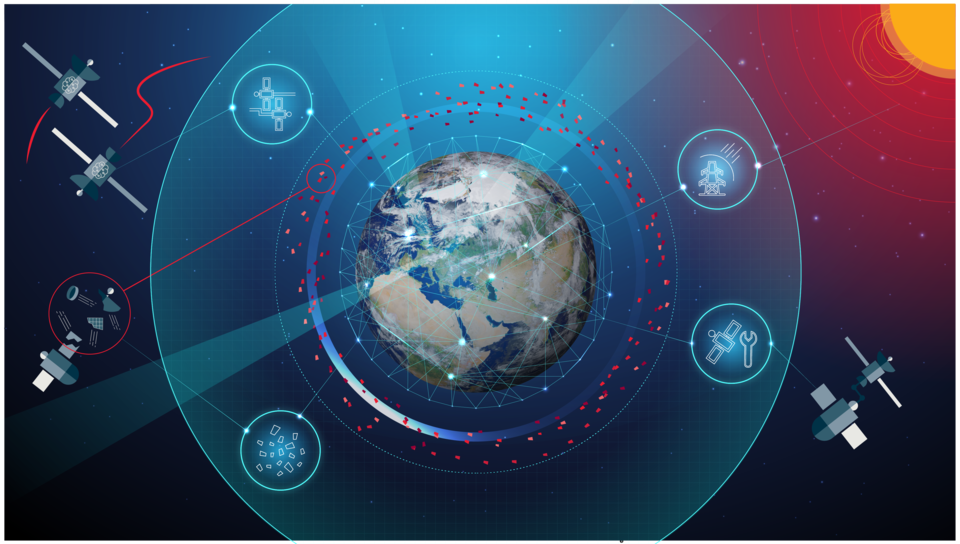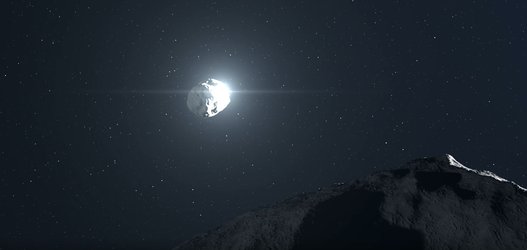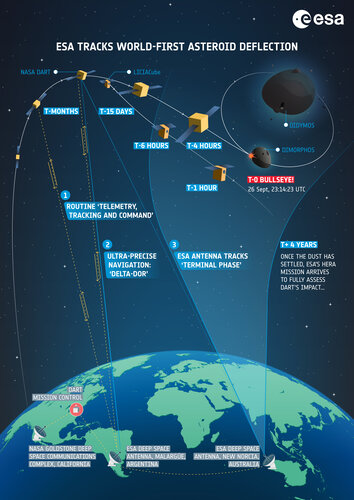ESA to capture light from deflected asteroid’s new plume
In brief
On 26 September, NASA will purposefully crash their DART spacecraft into the 160 m wide Dimorphos asteroid, in the first-ever test of deflection by means of ‘kinetic impact’. The moment the spacecraft collides with the asteroid a plume of material is expected to be thrown into space, which will tell us a great deal about the rock’s composition and how much energy has been transferred to it by the collision. ESA will contribute significantly to ground-based observations of the new plume, as telescopes contracted by the Agency’s Near-Earth Object Coordination Centre get ready to witness history.
In-depth
Over the past few years, astronomers have been very busy observing a pair of gravitationally bound asteroids, together in orbit around the Sun, to get precise data on their orbits. Dimorphos is the smaller ‘moonlet’ of the binary system, which orbits the larger, central asteroid, Didymos.

As DART impacts Dimorphos, it is expected to slightly alter the asteroid moon’s orbit around Didymos. To calculate how much the moon’s orbit is altered over time it's ‘light curve’ will be measured by observing the sunlight reflected from it with telescopes on the ground, and using this to calculate the change in the orbital period of the double-asteroid system. Satellites in orbit, including the Hubble and James Webb space telescopes will also join the effort.
Many of the ground-based telescopes participating in the light curve observing campaign won’t get a direct view of the moment of impact, because of Didymos’ position in relationship to Earth at the time. ESA’s Near-Earth Object Coordination Centre (NEOCC) will have eyes on the sky as DART strikes and a plume of material is expected to be ejected from the stricken asteroid.
Studying the first moments of this dusty plume will add to our understanding of the DART impact, revealing the amount of mass ejected and as a result, how much of a shove the colosseum-sized space rock has received.
What do we expect to see?

Don’t expect a detailed scene-by-scene video of the ‘boom’. LICIACube – a CubeSat launched with DART to witness the crash – will observe the plume just a few minutes after the impact, as it performs its close fly-by 55 km from the asteroid's surface. What we should see with telescopes on the ground is a dot in the sky that should, suddenly, increase in brightness.
The images expected, of a speck nestled amongst the stars, are the bread and butter of astronomical research – they should reveal a great deal.
“The more material ejected from the asteroid, the greater the amount of material available to reflect the sun's light and so the more it will increase in brightness in the sky,” explains Dora Föhring, Astronomer at ESA’s Near-Earth Object Coordination Centre.
“It’s the first time something like this has ever been tested, making it hard to predict just how much material will be released by the impact. Current estimates suggest it will increase in brightness by around a magnitude, but in the most extreme scenarios this could be as much as four.”

The time-critical moment when the plume is created is expected to take place quite suddenly, which adds to the complexity of the observations – because astronomers don’t know how much the asteroid will increase in brightness, it’s difficult to calibrate their instruments.
“Models predict this whole event will take place in two minutes, and it’s important we capture it as the properties of the very moment of impact will give us information about the kinetic impact as a whole,” explains Dora.
“We want to approach such a time-critical event with a clear plan and make sure all our systems have been carefully tested, calibrated and are good to go. However, there may always be the need to adjust in the hours leading up to the impact, depending on the local weather conditions. It’ll be an exciting challenge!”
What a humanmade ‘comet’ reveals
Dimorphos’ plume will turn the asteroid moonlet into a kind-of humanmade comet. Its temporary tail will take weeks to months to disperse, letting us peer into its insides to understand its composition, and importantly for planetary defence, how dense or loosely packed it is.

“A 160 m asteroid composed of loosely packed, ‘fluffy’ lumps of matter would have far less mass than a compacted, dense rock of the same size”, explains Marco Micheli, Astronomer at ESA’s NEOCC.
“That first asteroid would do less damage if it were to impact Earth, with more of it breaking up and burning up in our atmosphere. The latter asteroid, 160 m of dense rock or metal, would release much, much more energy.”
Aside from modelling Earth impacts and their consequences, we need to know the composition of any asteroid for if we ever need to impact it for real. Why? It's all about conservation of momentum. The kinematic impact from DART only provides a small change in momentum. However, if it creates a large amount of mass being excavated and pushed with a large velocity in the opposite direction, this will give an additional boost of momentum to Dimorphos going the other way.


Access the video
“The uncertainty in our predictions shows exactly why the DART mission is so needed, and why ESA’s follow-up Hera mission is such an exciting European contribution to this first test of planetary defence,” explains Ian Carnelli, Hera Mission Manager.
“Hera and its two CubeSats will travel to Dimorphos to study the crater formed by DART, its internal structure and composition, and get the most precise measurements of the asteroid’s mass. All the while it will test autonomous and low-gravity operations in deep space, vital for reconnaissance missions to any risky asteroid discovered one day for real”.
The Sun never rises on the NEOCC

Because of the position of Dimorphos in the sky at the time of impact, only telescopes in the red region shown here will be able to see it. This includes two contracted by ESA’s Near-Earth Object Coordination Centre: the 0.6 m Les Makes telescope on Réunion Island in the Indian Ocean and the 0.36 m Springbok telescope in Namibia.
In South Africa, the 0.5 m SMARTnet telescope, usually used to track space debris, will also be available to ESA, along with the 0.4 m Watcher telescope led by an Irish team. In Qatar and at Drebach-South Observatory in Namibia, a team of advanced amateur astronomers is also lending time on their telescope to ESA and its network.

Over the decades, ESA’s NEOCC has established a telescope network like no other. It is made up of the Agency’s own telescopes, those that are formally contracted and those available to ESA through ad hoc, informal agreements.
As it’s always night-time somewhere, this means the NEOCC can get rapid access to telescopes ‘in the dark’, whenever an observation is needed of a potentially risky object.
Follow @esaoperations on Twitter for live updates from ESA’s Planetary Defence Office and Estrack ground station network as we count down to the DART impact.
ESA’s vision for a safe future

ESA’s Planetary Defence Office, from the future Flyeye telescope that will scan the skies for new risky rocks and the experts tracking and calculating the risk of Earth impact and the Hera mission validating DART’s test of Planetary Defence, is protecting our planet and life on it.
Find out more about ESA’s vision for Space Safety in the coming years.














 Germany
Germany
 Austria
Austria
 Belgium
Belgium
 Denmark
Denmark
 Spain
Spain
 Estonia
Estonia
 Finland
Finland
 France
France
 Greece
Greece
 Hungary
Hungary
 Ireland
Ireland
 Italy
Italy
 Luxembourg
Luxembourg
 Norway
Norway
 The Netherlands
The Netherlands
 Poland
Poland
 Portugal
Portugal
 Czechia
Czechia
 Romania
Romania
 United Kingdom
United Kingdom
 Slovenia
Slovenia
 Sweden
Sweden
 Switzerland
Switzerland
































